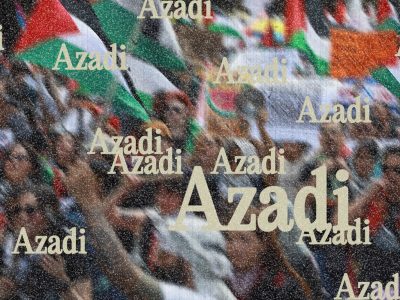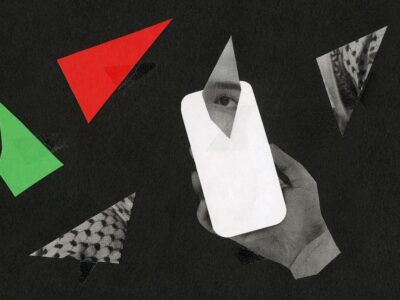WP_Post Object
(
[ID] => 9177
[post_author] => 15
[post_date] => 2025-09-02 20:19:11
[post_date_gmt] => 2025-09-02 20:19:11
[post_content] =>
How one word has birthed a globe-spanning tradition of resistance.
A few months ago, I was at a protest in Washington, D.C. This was not unusual. Gaza burns. The president deports with impunity. Respect for the rule of law—notably and especially by the government—now seems like the nostalgic artifact of a more innocent era, an era merely months ago. Unsurprisingly, for those of us moved by these simultaneous horror shows, expressing our anger through protest has become almost unremarkable. I’ve lost count of the number of protests I’ve attended, the catchy homemade signs I’ve crafted and seen, and the clever chants I’ve memorized. But at that particular march, something unusual happened: a chant-leader exhorted us to cry a word in my mother tongue, Urdu.
“Azadi!” she called.
“Azadi!” the crowd responded in unison.
Suddenly, the word seemed everywhere: scrawled in chalk across sidewalks and columns; emblazoned across signs. In the heart of the nation, the seat of its power, everywhere, that old watchword of uprising—Azadi.
~
Azadi, or freedom, is a small word. A scant five letters in both English and its original Farsi (آزادی), these five letters have birthed a globe-spanning tradition of resistance, having been shouted by students in Srinagar and Tehran, whispered in prison cells in Ankara, and sung by women in Kashmir and Delhi. A cry familiar to all children of the Middle Eastern and South Asian diaspora, myself included, Azadi is hymn, music, and lifeline. It’s a demand for dignity from its callers and from all those who answer the call.
This demand is expansive in scope and depth, inclusive of the dignity of life, of identity, and of the ability to govern your own political destiny. Azadi evokes our collective memory that freedom is claimed, not given, while narrating a people’s unified struggle for systemic social change. For those who seek the protection of the most vulnerable while preserving the dignity of all, Azadi is always within reach.
Still, for all that Azadi is, we must be clear about what it is not. It is not a slogan to be selectively invoked. It is not a justification for state violence. Azadi cannot mean the protection of innocent life only when politically convenient. Moreover, it becomes meaningless when uttered by those who do not uphold a politics grounded in human dignity. Nowhere was this distinction starker than in a recent televised address, in which Prime Minister Benjamin Netanyahu briefly switched from English to Farsi while commenting on Israel’s bombing of Iran. “Women, life, freedom. Zan, zendagi, azadi,” he said—invoking the slogan of the Iranian women’s rights movement. In that moment, the language of liberation was co-opted to justify the machinery of war. It was surreal to hear a feminist chant—professed often by Iranian women defying authoritarian rule—repurposed by the very man overseeing the brutally indiscriminate bombing of thousands of women and girls in Gaza. The slogan, stripped of its radical roots and repurposed as rhetorical cover, stood in direct contradiction to the grassroots movements that had once breathed life into it.
Creeping autocracy in the United States has for too long been ignored and shrugged off as a dysfunction that happens only in the Middle East and elsewhere in the Global South—the lawless other. But this careless, arrogant posture can no longer be supported, nor can the dangers of autocracy be reduced to a foreign export; and so, Americans chant Azadi now, because America needs it now. The past 100+ days have exhibited what the marginalized in this country have always known: that the greatest repression within America’s borders remains homegrown. Despotism collapses the political distance between nations and times, and just as fascism is rising globally, it has risen here. The myth of American exceptionalism falsely preached that our democracy was immune to the spell of demagoguery. But we know that Americans are just as capable of voting themselves into tyranny as any other people. White supremacy, toxic masculinity, and violent inequalities in rights and liberties were always part of the country’s domestic architectures. Now, from the streets to digital silos, they are plain for all to witness.
From Hungary to India, Israel to the U.S., authoritarian regimes the world over are in conversation, looking admirably upon each other. They swap notes in class, sharing tactics of repression, like aggrandizing executive power and politicizing independent institutions. But just as authoritarian regimes learn from each other, so too must we build solidarity across movements. The rhymes of history—from the surveillance of Black radicals in the U.S. to the targeting of Kashmiri students in India—demand collective study. And along with any new lessons that may arise, we must continue to echo the lessons of some of our most beloved visionaries. From Angela Davis to Edward Said to Arundhati Roy, we are reminded that global resistance is strongest when deeply rooted in local struggle.
In fact, therein lies Azadi’s greatest power: It crosses borders, languages, and faiths, moving between nations without itself becoming nationalized. It is a global grammar of defiance.
~
Language lives. It breathes, grows, reproduces. Azadi has done so, too, absorbing every movement and tongue it touches: Farsi, Urdu, Kurdish, Pashto, Punjabi, English. The precise journey of the word is contested; after all, linguistic borrowing is never an isolated event. Still, it carries an expansive genealogy of struggle through its travels: against gendered violence, against settler colonialism, against religious nationalism.
While I heard cries for Azadi in D.C. for the first time this year, in Indian-occupied Kashmir—the most militarized zone on earth—Azadi has been invoked for decades, having been part of the Kashmiri liberation movement since its inception. Yet as Modi’s India forbids conversations about the region and brands it as sedition, as students and organizers are arrested for expressing their desire for freedom, as the indigenous Kashmiri struggle for self-determination persists—Azadi remains the movement’s heartbeat.
Long serving as the anthem of the Kashmiri separatist movement, now that Azadi can no longer be expressed in the open, it hides itself in art or in niche digital spaces not yet subject to state discipline. Digital speech, however, is increasingly policed. On platforms like X (formerly Twitter), Indian authorities now block, geofence, or suspend accounts that challenge its narrative. Content from advocacy groups like Stand With Kashmir is censored using the same tools of repression that platforms in the U.S. deploy against pro-Palestinian activists—algorithms, shadowbanning, keyword suppression. Surveillance and censorship, previously characterized as exclusive to so-called illiberal regimes, are now a feature of the liberal democracies just catching up.
As all this occurs, state actors escalate their repression of dissent in the United States. Trumpism has made it clear what can and cannot be said: speech critical of the Trump administration is met with swift retribution; and speech challenging domestic and foreign policy is quickly vilified, as seen by the vicious response to ICE protests in California earlier this summer. Meanwhile, students protesting for Palestine in the U.S. now face the same brutal state retaliation we’ve long associated with authoritarian regimes abroad—even though the U.S. has always had its own archive of violent suppression, from the surveillance and silencing of civil rights activists and abolitionists to the the crackdown on anti–Vietnam War protesters after them. Today, much to Trump’s delight, some of the most prestigious law firms have capitulated to executive pressure, agreeing to perform approximately $1 billion worth of pro-bono labor for Trump’s retributive pet projects. Activists and pro-Palestine advocates have been doxxed, fired, expelled, and/or blacklisted. All the while, institutional liberalism bends the knee: DEI offices that once promised safe harbor for marginalized voices now fall silent or side with power; liberal media outlets fire staff who speak out against atrocities in Gaza. The suppression of speech, criminalization of protest, surveillance of dissent—these are global patterns, and we are not exempt. Arguably, if American exceptionalism matters here at all, it will be in its ability to normalize this authoritarian bent worldwide.
And yet resistance continues. The same dignity Azadi rallies for abroad is now demanded here. On the steps of American universities. In its hallowed institutions. At the foot of the Capitol.
~
For all that Azadi gives, it demands something of us—namely that we do more than simply bear witness. When we chant Azadi, we are not just echoing other movements, past and present, but entering into dialogue with them, from Kashmir to Kabul to Tehran. This is not mimicry, but lineage, as Azadi reminds us in every generation that our rights are not guaranteed and must be renewed through struggle.
It is not enough, then, to be the appreciative, passive inheritor of a tradition of resistance; one must mobilize. This means texting rideshares, learning how to administer basic first aid for those whose names you don’t yet know, and tracking jail releases of those who you just met and marched alongside. This means disagreement without collapse, and accountability without exile. This means spending hours in rooms with bad lighting and too many opinions, trying to move toward consensus anyway.
If Azadi is to continue to mean something lasting, we’ll need to carry it beyond the chants—into policy fights, mutual aid networks, protective kinship, and more. Because Azadi is not metaphor, it is mandate, and requires all of us to answer its call.
~
Call and Response:
Hum kya chahte? Azadi!
What do we want? Freedom!
Chheen ke lenge—Azadi!
We will snatch it—Freedom!
Hai haq hamara—Azadi!
It is our right—Freedom!
Zor se bolo—Azadi!
Say it louder—Freedom!
Hai jaan se pyaari—Azadi!
We love it more than life—Freedom!
Tum kuch bhi kar lo, hum leke rahenge—Azadi!
Do what you want, we will still win it—Freedom!
[post_title] => America Needs Azadi
[post_excerpt] => How one word has birthed a globe-spanning tradition of resistance.
[post_status] => publish
[comment_status] => closed
[ping_status] => closed
[post_password] =>
[post_name] => america-united-states-azadi-freedom-protest-palestine-gaza
[to_ping] =>
[pinged] =>
[post_modified] => 2025-09-03 10:27:10
[post_modified_gmt] => 2025-09-03 10:27:10
[post_content_filtered] =>
[post_parent] => 0
[guid] => https://conversationalist.org/?p=9177
[menu_order] => 4
[post_type] => post
[post_mime_type] =>
[comment_count] => 0
[filter] => raw
)

